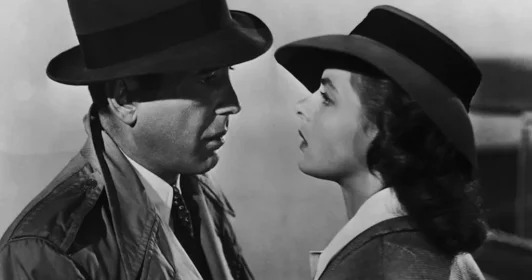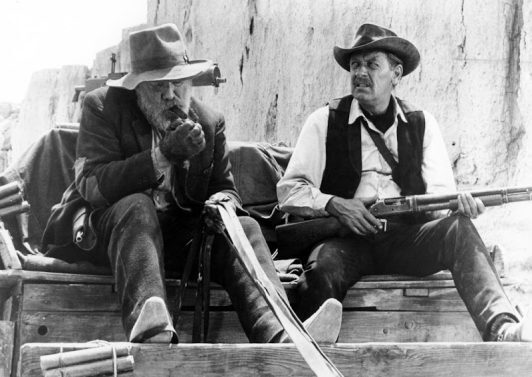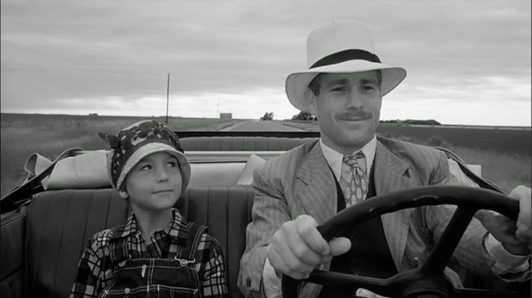Steven Pressfield's Blog, page 6
October 23, 2024
Get to “I Love You” – Part 4
The “Get to ‘I love you'” principle works for tragic endings too. Even if the lovers are torn apart by fate or necessity, if we as storytellers can leave them with a moment where they declare their love, even if it’s silent or doomed … we’ve got something good.

The classic in this category is the ending of Casablanca, when Bogey puts Ingrid on the plane to Lisbon, giving up his shot at this love-of-his-life for the higher calling of freeing her (and her Resistance leader husband, played by Paul Henreid) to carry on their heroic work.
INGRID
But what about us?
BOGEY
We’ll always have Paris.
In other words, “I love you.”
Another great moment of this type is the final scene of the first Godfather. This one is all visual. No dialogue.
The moment takes place in the Don’s house in New Jersey. In the background, we see the new don, Michael Corleone (played by Al Pacino), receiving the obeisance of his capos, who kiss his ring and address him as “Godfather” for the first time. In the foreground is Michael’s wife Kay, played by Diane Keaton, folding household laundry, willfully oblivious of the moment that is playing out behind her. One of the capos slowly closes the door to Michael’s office, shutting out Kay forever.
This is “I love you” in its most heartbreaking and emotionally powerful forms.
No wonder AFI has Casablanca at #2 on its all-time list and The Godfather at #3. (Citizen Kane edged them both out.)
The post Get to “I Love You” – Part 4 first appeared on Steven Pressfield.October 16, 2024
Get to “I Love You” – Part 3
It doesn’t have to be romantic lovers to make this storytelling principle work. It can be friends. It can be enemies.

After the final bloodbath sequence in Sam Peckinpah’s The Wild Bunch, Deke Thornton (played by Robert Ryan), who had been pursuing the outlaw band throughout the movie, comes upon the shot-to-hell corpse of the Bunch’s leader, Pike (played by William Holden.) Pike, though dead, clings to the trigger mechanism of the .50-caliber machine gun he’d been firing in the preceding blood-and-guts scene.
Deke had once been a friend of Pike’s and still respects and admires him, even though he’s been chasing him, trying to kill him, throughout the whole picture.
Deke spots Pike’s six-shooter, still in its holster on Pike’s hip. He reaches and takes it.
In other words, “I love you.”
Another great moment between non-lovers is the finish of the movie version of Ken Kesey’s One Flew Over the Cuckoo’s Nest.
This is the scene where Randle McMurphy (played by Jack Nicholson) has been returned to the psychiatric ward, having been lobotomized. His friend, Chief Bromden, played by Will Sampson, stands over the bed, heartbroken at what the hospital powers have done to the man who always believed in him and told him he should be free.
Chief places a pillow over McMurphy’s face and releases him from his shattered life, then uses the physical strength he had possessed all along but had never had the courage to put into play—and breaks through the hospital wall and escapes.
“I love you” doesn’t have to be said in words, and it doesn’t have to be between lovers.
The post Get to “I Love You” – Part 3 first appeared on Steven Pressfield.October 9, 2024
Get to “I Love You” – Part 2
We said in last week’s post that an extremely useful principle of storytelling is “Get to ‘I love you’.” Meaning structure the novel or movie so that two clashing opposite or unlikely people move from indifference to each other (or outright hostility) to that great moment when they can look in each other’s eyes and say, “I love you.”
But it’s even better if the line that means “I love you” says the exact opposite. In other words, the text says one thing but the subtext says another. And the subtext wins.

In Peter Bogdanovich’s Paper Moon (from the novel “Addie Pray” by Joe David Brown), nine-year-old Addie Loggins (played by Tatum O’Neal ) is an orphan in Depression-era Kansas who goes on the road with flim-flam man Moses Pray (played by Ryan O’Neal, her real-life father). Addie’s wish through the whole story is to prove that Moses is her father in the movie—and to stay with him.
In the final sequence of the picture, Moses drops Addie off with her true aunt in Saint Joseph, Missouri, deciding that his flim-flam ways and life on the road are not healthy for a young girl. But Addie immediately bolts from the nice-but-very-dull aunt and chases Moses on foot down a country road. She catches him where he has stopped, feeling unsure about his decision. When Moses sees Addie running toward him, he gets out of his broken-down Model-T truck and confronts her.
MOSES
I told you I don’t want you ridin’ with me no more.
Addie is heartbroken. Then, suddenly, Moses’ truck’s brakes fail … the old clunker starts rolling away down a hill.
ADDIE
Mose! Look!
Moses groans, grabs the few belongings that Addie is carrying (her radio and pint-size suitcase) and dashes to catch the runaway truck. Addie follows. He leaps on board from one side, she springs up from the other. As the truck wheezes away down a road soaring to the horizon, the song “Keep Your Sunny Side Up” plays on the soundtrack.
In other words, “I love you.”
The post Get to “I Love You” – Part 2 first appeared on Steven Pressfield.October 2, 2024
Get to “I Love You” – Part 1
One of the principles I (sometimes) use in structuring a story is: Get to “I love you.”
Have you ever seen Billy Wilder’s great 1960 love story, The Apartment? The classic ending line (from Shirley MacLaine to Jack Lemmon) as they sit down to a one-on-one game of gin rummy is, “Shut up and deal.” By which she means, “I love you.”

If you and I as writers can start our story with two people (preferably potential lovers) as far apart as possible and bring them, by story’s end, to the place where they can say, “I love you” … we’ve got something.
It doesn’t have to be literally, “I love you.” In fact, it’s better if the line or lines are as different from that as we can make them … as long as our readers or moviegoers understand that the words mean exactly that.
In the movie Fight Club, the narrator/hero without a name (played by Edward Norton) forces Marla Singer (Helena Bonham Carter) onto a bus leaving New York City. He and she have been clashing, crazy, we-can’t-make-this-work lovers throughout the picture. Now he’s stuffing cash into her hand and compelling her to get out of town to protect her from some bad stuff that’s about to happen.
Marla mounts to the first step of the bus, then turns back to Norton.
MARLA
“Tyler, you’re the worst thing that ever happened to me.”
Meaning, “I love you.”
The post Get to “I Love You” – Part 1 first appeared on Steven Pressfield.September 25, 2024
The Crazier the Better
My friend Paul is writing a cop novel. He’s never written anything so ambitious before; he’s in unknown territory, over his head. Even scarier for him, his story is coming out very dark. “I mean twisted, weird-dark,” he says. “So dark it’s scaring me.”
Paul wants to know if he should throttle back. He’s worried that the book will come out so evil, not even Darth Vader will want to touch it.

Answer: no way.
The darker the better, if that’s how it’s coming to him.
Why? Because for artists and entrepreneurs—particularly those at the beginning of their careers—Job #1 is testing their limits, finding out who they are. The sane and the ordinary are the enemies of all artists, but especially of those just stretching their wings.
The post The Crazier the Better first appeared on Steven Pressfield.September 18, 2024
Resistance Doesn’t Go Away on the Artist’s Journey
The Fifth Rule of the Artist’s Journey is:
It never gets easier.

We may recognize Resistance now (which is vastly different from before, when we were blind to its existence and it held us, helpless, in its thrall.) We may understand the enemy now, and we may know how to fight it.
But the dragon never goes away.
We have to slay it anew, every morning.
The post Resistance Doesn’t Go Away on the Artist’s Journey first appeared on Steven Pressfield.September 11, 2024
The Artist’s Journey Is a Lifetime Engagement
The Fourth Rule of the Artist’s Journey is:
It’s for life.

No artist or entrepreneur (or human being) finds her voice at age X and puts it on cruise control from then on. That voice is constantly evolving.
Beneath every level of understanding lies another level, and another after that.
Even the most fully-realized genius declares on her deathbed, “I was just getting started.”
The post The Artist’s Journey Is a Lifetime Engagement first appeared on Steven Pressfield.September 4, 2024
Whatever You Think Your Limits Are, You’re Wrong
The Third Rule of the Artist’s Journey is:
If you imagine you know your limits, you’re mistaken.

I have a recurring dream. I’m moving through my house and I discover a room I’ve never seen before. Sometimes I’ll find an entire wing. I’ll stumble onto billiard rooms and libraries and great, candlelit ballrooms filled with revelers.
Those rooms are parts of myself that I didn’t know existed.
You have those rooms too.
All of us contain mansions and galleries and gardens that we’ve never encountered, that we had no idea existed.
Those places are where we create from.
If you think you know what you’re good at, think again. Trust me: you can do stuff you’ve never even dreamed of.
There are rooms and more rooms in our house, and more rooms after that.
The post Whatever You Think Your Limits Are, You’re Wrong first appeared on Steven Pressfield.August 28, 2024
Whatever You Think You Know About Yourself, You’re Wrong
The Second Rule of Artist’s Journey is this:
If you think you know who you are, you’re wrong.
Hunter S. Thompson’s ambition was to write like Scott Fitzgerald. He copied the whole of The Great Gatsby, trying to teach himself to compose sentences that flowed with the effortless grace of those penned by his hero. How surprised must the avatar of gonzo journalism have been to find his true voice, not in This Side of Paradise but in Fear and Loathing in Las Vegas and Generation of Swine?

The stories we tell ourselves about ourselves are almost always wrong. That’s their nature. The purpose of these self-conceived narratives is to keep us comfortably unconscious. We tell ourselves these stories so we can avoid the pain of diving deep, to the real story underneath.
The artist’s journey is the dive through the faux story to the true one.
The post Whatever You Think You Know About Yourself, You’re Wrong first appeared on Steven Pressfield.August 21, 2024
The Price of the Artist’s Journey
The First Rule of Artist’s Journey is this:
However hard you think it will be, the reality is ten times harder.
However long you imagine it will take, the term is ten times longer.
However much you think it will cost, the bill is ten times higher.

Charles Bukowski said that he wrote for thirty years before he finally composed a single sentence that was true to his vision. Mathew Syed’s Bounce and Malcolm Gladwell’s Outliers both posit ten years of full-time work—ten thousand hours—to achieve mastery in any field.
(It goes without saying that in art or entrepreneurship, “mastery” is a guarantee of absolutely nothing.)
Robert McKee has a criterion that he applies to the protagonist in any novel, play or movie. Does this character possess the drive and passion—the madness—to see the story all the way through to the end? Will he or she go to any length, pay any price to achieve his or her goal? If the answer is no, there’s no movie.
Same with us on the artist’s journey. Only we can answer:
How much do we love it?
How much do we want it?
How much are we willing to give to achieve it?
The post The Price of the Artist’s Journey first appeared on Steven Pressfield.


